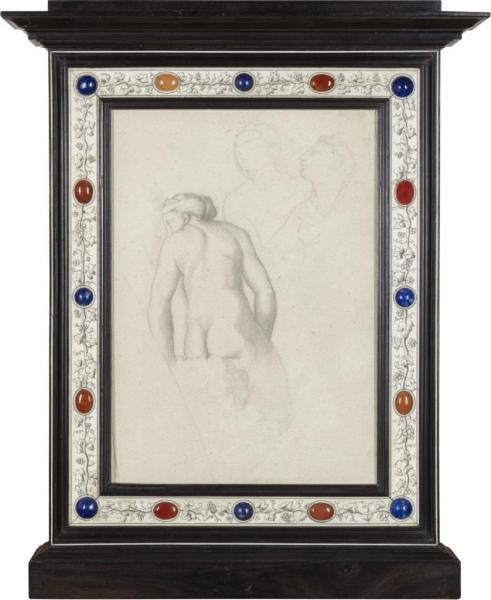Etude de dos féminin et deux profils d'après Raphaël "Cupidon et les trois Graces"
Pencil on paper, stamped on the back.
22.50 x 15.50 cm
Provenance :
Edgar Degas Estate
Collection Henri Rabeau (1889-1968) then by descent
Private collection, France
This drawing will be included in the supplement to the Catalogue Raisonné of Edgar Degas being prepared by Paul Lemoine for the Galerie Brame et Lorenceau.
The inspiration for this exquisite drawing by Degas is the Decoration of the Loggia di Psiche in the Villa Farnesina (1517-18) by Raffaello Sanzio (1483-1520) known as Raphael. In 1517 Agostino Chigi commissioned Raphael to decorate the ground floor loggia of the villa in which the artist had painted the Galatea a few years before. The frescoes represent the Story of Psyche, a myth derived from the Golden
Ass of Apuleius (2nd century A. D.). The cycle of pictures appears only on the ceiling. Raphael's pictorial narrative in the Loggia di Psiche begins in the spandrels of the short side on the left as one enters and continues along the spandrels to the right to the second short side and then along the entrance side. These triangular surfaces represented a problematic format for artists. Raphael solved this challenge in ever new and surprising ways, causing the form of the painting's support and the composition of its figures to interact in particularly fortuitous and varied manners. In this spandrel Cupid, who is already in love with Psyche, is pointing her out to the Graces. The figures are skillfully placed within the form of the spandrel such that they face in from all four sides and seem to push the space out with their backs and shoulders. This gives the group air and freedom in the centre without causing it to fall apart: the bodies interlock, overlap, and combine.
In contrast to the general Impressionist enterprise of trying to catch the fleeting, transient moment,
Degas famously said of his work: "No art was ever less spontaneous than mine; what I do is the
result of reflection and the study of Old Masters."
Degas's most intense period of study of Old Masters was the three years he spent in Italy in his
early twenties, from 1856 to 1859. He had family connections in Naples and Florence, but spent
about half his time in Rome. Almost all the large body of paintings and drawings - many of them
copies of Italian works that Degas took back to France - remained in his Paris studio until his death
in 1917, and he constantly referred to them for inspiration.

